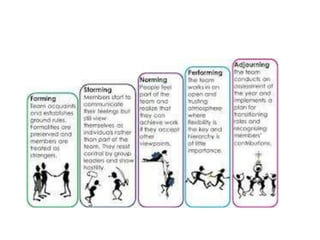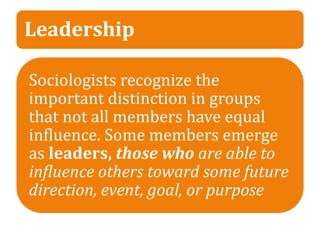Sociology 13 social groups
- 3. SOCIAL GROUPS The term group has a specific definition in sociology that differs from everyday usage However, two or more people being in close physical proximity does not constitute a group in the sociological meaning of the word. Sociologically speaking, a group is a collection of people who interact regularly based on some shared interest and who develop some sense of belonging that sets them apart from other gatherings of people.
- 4. TYPES OF GROUPS • Primary group • Secondary groups • reference group
- 5. Primary group • According to Charles Horton Cooley (1864–1929), a primary group is a small social group whose members share personal and lasting relationships. People joined in primary relationships spend a great deal of time together, engage in a wide range of activities, and feel that they know one another well. • In short, they show real concern for one another. In every society, the family is the most important primary group. • Groups based on lasting friendships are also primary groups
- 6. Secondary groups • in contrast to primary groups, are large groups involving formal and institutional relationships. Secondary relationships involve weak emotional ties and little personal knowledge of one another. Most secondary groups are short term, beginning and ending without particular significance
- 7. reference group • A reference group is a group to which an individual or another group is compared.
- 8. Some examples of types of groups include the following: • Peer group • A peer group is a group with members of approximately the same age, social status, and interests. • Generally, people are relatively equal in terms of power when they interact with peers. • CliqueA group of people that have many of the same interests & commonly found in a High School/College setting; most of the time they have a name & rules for themselves.
- 9. • Club • A club is a group, which usually requires one to apply to become a member. Such clubs may be dedicated to particular activities: sporting clubs, for example. • Cabal • A cabal is a group of people united in some close design together, usually to promote their private views or interests in a church, state, or other community, often by intrigue. • Household • All individuals who live in the same home. Anglophone culture may include various models of household, including the family, blended families, share housing, and group homes.
- 10. • Community A community is a group of people with a commonality or sometimes a complex net of overlapping commonalities, often–but not always–in proximity with one another with some degree of continuity over time. Franchise An organization which runs several instances of a business in many locations .Gang A gang is usually an urban group that gathers in a particular area. It is a group of people that often hang around each other. They can be like some clubs, but much less formal. They are usually known in many countries to cause social unrest and also have negative influence on the members and may be a target for the law enforcers in case of any social vices • Mob A mob is usually a group of people that has taken the law into their own hands. Mobs are usually groups which gather temporarily for a particular reason.
- 11. • Posse A posse was originally found in English common law. It is generally obsolete, and survives only in America, where it is the law enforcement equivalent of summoning the militia for military purposes. However, it can also refer to a street group. • Squad • This is usually a small group, of around 3 to 15 people, who work as a team to accomplish their goals. • Dyad(a group of two people) This is a social group with two members. Social interaction in a dyad is typically more intense than in larger groups because neither member shares the other's attention with anyone else.
- 12. • Triad This is a social group with three members, which contains three relationships, each uniting two of the three people. A triad is more stable than a dyad because one member can act as a mediator should the relationship between the other two become strained. • Team Similar to a squad, though a team may contain many more members. A team works in a similar way to a squad. • In-groupIt is a social group toward which a member feels respect and loyalty. It is a group that an individual identifies in positive direction. If a person is part of the in-group then they are collectively part of an inner circle of friends. An inner circle may contain sub-groups within the inner circle including the apex (best friends), core (very close friends), outer rim, etc. This group provides a support structure and being exclusive offers protection from anyone in an Out-group (see below.)
- 13. • Out-group It is a social group toward which a person feels a sense of competition or opposition. – It is a group that an individual identifies in negative direction.
- 19. Researchers have also pointed out that sometimes categorizations are as basic in our minds as those groups with which we identify and feel a sense of belonging and loyalty, in-groups, and those with which we do not identify or toward which we may even feel animosity, out- groups.
- 23. Reference Groups Sociologists are also interested in how we use groups to judge ourselves and our attitudes, beliefs, behaviors, and actions (Hyman 1942; Hyman and Singer 1968; Singer 1981). The groups we use for this purpose are reference groups. Reference groups are those with which we compare ourselves. Any group can become a reference group if we use them to judge something about ourselves. Considering what best friends will think about your new boyfriend or girlfriend or how to dress to fit in with your new colleagues on your first day of work are both ways of using reference groups.
- 24. Group Size Group size influences the interactions that take place within the group. This group of two is called a dyad. A three-person group is a triad.
- 25. NETWORKS Sociologists have also demonstrated the importance of our relationships that occur outside of defined groups in networks, the patterned relationships that connect us with those outside of our established groups.
- 26. GROUP DYNAMICS An entire field of study known as group dynamics has developed around the scientific study of groups and group processes. group dynamics includes studying the influences groups have on our behavior
- 27. Group Formation Many groups are formed to accomplish some task. This requires that the members work together somewhat as a team.
- 28. Leadership Sociologists recognize the important distinction in groups that not all members have equal influence. Some members emerge as leaders, those who are able to influence others toward some future direction, event, goal, or purpose
- 29. Power Leaders have differential levels of power, the ability to influence others, even if those others resist
- 30. Conformity Sociologists and their colleagues in fields such as social psychology have demonstrated that groups can shape members’ behavior in powerful ways. Groups may require members to conform, sharing certain norms, values, behaviors, and sometimes even opinions.
- 31. Obedience































